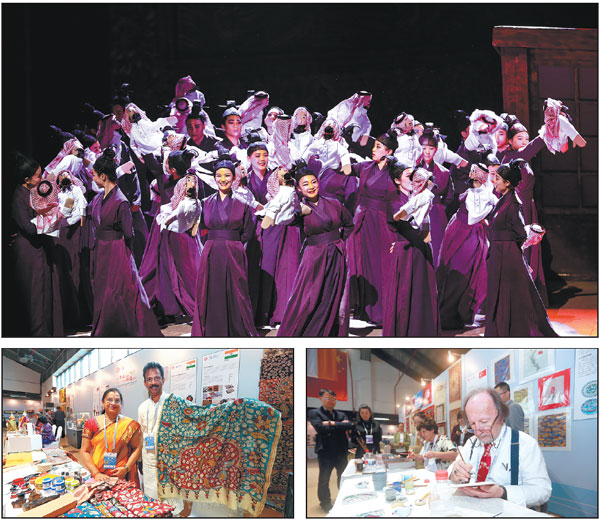Festival showcases hosts' unique legacies
Event has drawn over 1,200 artists and visitors from some 40 countries and regions
The ongoing Maritime Silk Road International Arts Festival, now in its fourth session, has become a gala for international cultural exchanges and a showcase to display the unique cultures of host city Quanzhou and host province Fujian, according to local officials.
The festival opened on Nov 22 in the coastal city of Quanzhou in Fujian province and will conclude on Wednesday.
"The event is designed as a meeting of multiple cultures and a carnival for people from various countries," said Kang Tao, Party secretary of Quanzhou and head of the executive committee of the festival.
|
Clockwise from top: The singing and dancing show combining both human and puppet performances during the opening ceremony is a highlight of the fourth Maritime Silk Road International Arts Festival. Chen Yingjie / For China Daily. A Turkish artist makes colored porcelain during the festival. Cai Zimin / For China Daily. Two indian artists show their hand-woven fabric during the event. Chen Yingjie / For China Daily |
According to the committee, more than 1,200 international artists and visitors, as well as 130 cultural and art organizations from over 40 countries and regions are gathering in Quanzhou to present the cultural legacies of their own.
Kang said the event is also a festival of the people as it has involved the wide participation of residents and visitors. People are offered a new experience of the event because it is held throughout the city and it is highly interactive through the internet and other technological means.
The festival includes a variety of activities that cover exhibitions of arts, performances and forums.
The opening ceremony on Nov 22 was the highlight of the festival with a deliberately designed singing and dancing show.
The show depicted a story happening during the Song (960-1279) or Yuan (1271-1368) dynasty, when Quanzhou was a hub of the ancient Maritime Silk Road. It is about a trip of a local puppet troupe from Quanzhou to Egypt.
A combination of performances of humans and puppets, the show aims to praise the courage of ancient Chinese in exploring the oceans and promoting cultural exchanges. It also brought the marionette of Quanzhou, which is on the national list for intangible cultural assets protection, to the spotlight.
Another highlight of the event is the exhibition of cultural legacies from across the world at the newly opened Quanzhou Museum of Intangible Cultural Assets.
A total of 130 intangible cultural assets projects from 11 countries are on display at the museum, in addition to more than 80 projects from China.
The projects are not mere exhibitions of items - they involve the whole process of techniques and skills demonstrated by artists on the site.
There are also interactions between the visitors and artists through on-site trainings and online demonstrations.
Li Yaying, a senior official from the Ministry of Culture and Tourism, which is one of the organizers of the event, said the festival is an important part of China's efforts to develop international cooperation centering on the Belt and Road Initiative.
She said the event is also beneficial to the local tourism industry as tourist attractions in Quanzhou and Fujian are set to get more attention as a result of the tours of visiting guests, especially the study trips of tourism industry insiders and officials and experts in the fields of arts and cultural legacies.
Wu Xiande, head of Fujian Provincial Culture and Tourism Department, said the festival plays an important role for Fujian to deepen exchanges and cooperation in culture and tourism with countries and regions along the 21st Century Maritime Silk Road.
In addition to using major international events like the Maritime Silk Road International Arts Festival and Maritime Silk Road International Tourism Festival, Fujian has also set up overseas offices to promote its culture and tourism.
These include five cultural promotion offices and seven tourism promotion offices, according to Wu.
Fujian has been designated by the central government as a "hub region of 21st Century Maritime Silk Road", due to its historical contribution to the ancient maritime trade route and its current status in developing cooperation with countries and regions involved in the BRI, Wu said.
Quanzhou was one of the hubs for China's maritime trade during the Tang (618-907) and Song dynasties, with great amount of tea, silk and porcelain products shipped from its ports to Asia, Africa and Europe.
Quanzhou is home to 34 national intangible cultural heritage items and four items have been included in the UNESCO Representative List of the Intangible Cultural Heritage of Humanity.
The city is building industrial chains and brands for protecting and developing cultural heritage, which includes Dehua porcelain, Hui'an stone carving, Anxi tea and Yongchun incense.
By now the city has over 6,000 arts and crafts companies with about 400,000 people involved in the sectors, data from the local government showed.
(China Daily 11/26/2019 page19)















